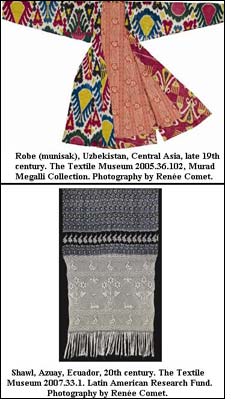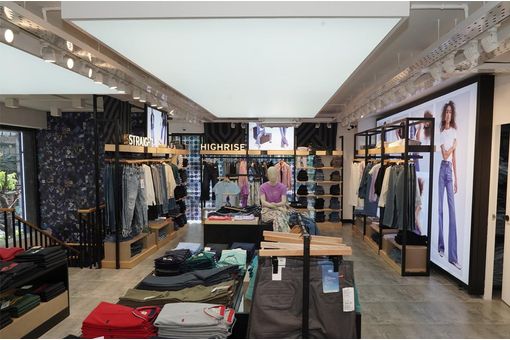Interviews
19 diverse objects of textile arts to be featured at Recent Acquisitions
05 Mar '09
5 min read

Textiles in the Exhibition
The objects presented in Recent Acquisitions boast origins in such diverse regions as Peru, Indonesia, India, Cameroon, Bhutan, Georgia, Iran, Turkey and France. Most of the pieces are garments, but the exhibition also includes hangings or panels, a saddlebag and other items.
One of the stand-out pieces in the exhibition is a Chinese robe made of kesi (tapestry-woven silk) which would have been worn by an upper-class woman of Manchu ethnicity during the 19th century, mainly for informal occasions in the autumn. China's last imperial dynasty, the Qing (1644–1911), was created when the Manchus assumed power.
Even as they rose to dynastic rule, the Manchus retained their native styles of dress, including full length robes such as the one newly accepted into the Museum's collection. Its pattern of scattered flowers and symbols of long life is closely associated with the Empress Dowager Cixi (1835–1908). The first Manchu robe to be added to The Textile Museum's collection, this elegant piece belonged to Jane Ickes, wife of Harold Ickes, Secretary of the Interior under President Franklin D. Roosevelt.
Central Asian ikats, particularly the fabrics made in Uzbekistan, have some of the most graphically striking patterns produced in any culture. Binding and dyeing the bundled warps – and sometimes also the wefts – before weaving is initiated results in patterns with characteristic softly defined edges. The practice of calendaring, or applying a shiny and highly polished finish of egg white or special glue, gives fabrics an even more brilliant, reflective sheen.
The splendid munisak, a woman's robe from Uzbekistan, on view in Recent Acquisitions, was created using both ikat and calendaring. The robe features brilliantly colored forms set against a white background, creating a sharp contrast. Tailored with a close-fitting, pinched waist and a flared skirt, the robe is lined with a Russian printed cotton fabric decorated with paisleys, stripes and roses. The Textile Museum received this robe as part of a magnificent group of Central Asian ikats given by collector Murad Megalli in 2005. This collection will be the subject of a major exhibition at The Textile Museum in the fall of 2010.
Ikat dyeing was practiced in many other cultures around the world, including traditional cultures in South America. A third notable item which will be on view in Recent Acquisitions is an Ecuadorian shawl consisting of one loom panel with an indigo-dyed ikat design with little dogs on a mottled background and a horizontal border of birds on each end.
The extended white warp fringe of the shawl has been fashioned in macramé (ornamental knot work) to form a design of floral bouquets separated by birds and dogs, framed by a border of geese above and below. The shawl was collected in Cuenca, in the highlands, in the early 1970s and was probably relatively new then. The style is thought to be traceable to Peruvian shawls seen around 1900 in Loja, a city to the south.
These and the other diverse objects offered for the public's enjoyment and learning in Recent Acquisitions form a small celebration of the diversity and high quality of The Textile Museum's holdings, as well as the taste, knowledge and generosity of the Museum's donors.
The objects presented in Recent Acquisitions boast origins in such diverse regions as Peru, Indonesia, India, Cameroon, Bhutan, Georgia, Iran, Turkey and France. Most of the pieces are garments, but the exhibition also includes hangings or panels, a saddlebag and other items.
One of the stand-out pieces in the exhibition is a Chinese robe made of kesi (tapestry-woven silk) which would have been worn by an upper-class woman of Manchu ethnicity during the 19th century, mainly for informal occasions in the autumn. China's last imperial dynasty, the Qing (1644–1911), was created when the Manchus assumed power.
Even as they rose to dynastic rule, the Manchus retained their native styles of dress, including full length robes such as the one newly accepted into the Museum's collection. Its pattern of scattered flowers and symbols of long life is closely associated with the Empress Dowager Cixi (1835–1908). The first Manchu robe to be added to The Textile Museum's collection, this elegant piece belonged to Jane Ickes, wife of Harold Ickes, Secretary of the Interior under President Franklin D. Roosevelt.
Central Asian ikats, particularly the fabrics made in Uzbekistan, have some of the most graphically striking patterns produced in any culture. Binding and dyeing the bundled warps – and sometimes also the wefts – before weaving is initiated results in patterns with characteristic softly defined edges. The practice of calendaring, or applying a shiny and highly polished finish of egg white or special glue, gives fabrics an even more brilliant, reflective sheen.
The splendid munisak, a woman's robe from Uzbekistan, on view in Recent Acquisitions, was created using both ikat and calendaring. The robe features brilliantly colored forms set against a white background, creating a sharp contrast. Tailored with a close-fitting, pinched waist and a flared skirt, the robe is lined with a Russian printed cotton fabric decorated with paisleys, stripes and roses. The Textile Museum received this robe as part of a magnificent group of Central Asian ikats given by collector Murad Megalli in 2005. This collection will be the subject of a major exhibition at The Textile Museum in the fall of 2010.
Ikat dyeing was practiced in many other cultures around the world, including traditional cultures in South America. A third notable item which will be on view in Recent Acquisitions is an Ecuadorian shawl consisting of one loom panel with an indigo-dyed ikat design with little dogs on a mottled background and a horizontal border of birds on each end.
The extended white warp fringe of the shawl has been fashioned in macramé (ornamental knot work) to form a design of floral bouquets separated by birds and dogs, framed by a border of geese above and below. The shawl was collected in Cuenca, in the highlands, in the early 1970s and was probably relatively new then. The style is thought to be traceable to Peruvian shawls seen around 1900 in Loja, a city to the south.
These and the other diverse objects offered for the public's enjoyment and learning in Recent Acquisitions form a small celebration of the diversity and high quality of The Textile Museum's holdings, as well as the taste, knowledge and generosity of the Museum's donors.
The Textile Museum
Popular News
Leave your Comments
Ata Turgutalp
Eliar Elektronik San. A.S.
































-Ltd..jpg?tr=w-120,h-60,c-at_max,cm-pad_resize,bg-ffffff)





.jpg?tr=w-120,h-60,c-at_max,cm-pad_resize,bg-ffffff)
.jpg?tr=w-120,h-60,c-at_max,cm-pad_resize,bg-ffffff)






